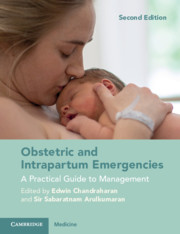Book contents
- Obstetric and Intrapartum Emergencies
- Obstetric and Intrapartum Emergencies
- Copyright page
- Contents
- Contributors
- Preface
- Preface to the First Edition
- Acknowledgements
- Section 1 General Principles
- Section 2 Algorithms for Management of the Top Five ‘Direct Killers’
- Section 3 Intrapartum Emergencies
- Section 4 Postpartum Emergencies
- Section 5 Medical and Surgical Emergencies During Pregnancy
- Section 6 Anaesthetic Emergencies During Pregnancy
- Chapter 32 General Anaesthesia and Failed Intubation
- Chapter 33 Fluid Overload and Underload
- Chapter 34 Transfusion and Anaphylactic and Adverse Drug Reactions in Pregnancy
- Chapter 35 Major Trauma Including Road Traffic Accidents
- Section 7 Neonatal Emergencies and the Management of Immediate Neonatal Problems
- Section 8 Management of Anticipated and Non-anticipated Emergencies in Pregnancy
- Section 9 Setting-Up Skills and Drills Training in Maternity Services and Reducing Avoidable Harm
- Index
- References
Chapter 33 - Fluid Overload and Underload
from Section 6 - Anaesthetic Emergencies During Pregnancy
Published online by Cambridge University Press: 06 May 2021
- Obstetric and Intrapartum Emergencies
- Obstetric and Intrapartum Emergencies
- Copyright page
- Contents
- Contributors
- Preface
- Preface to the First Edition
- Acknowledgements
- Section 1 General Principles
- Section 2 Algorithms for Management of the Top Five ‘Direct Killers’
- Section 3 Intrapartum Emergencies
- Section 4 Postpartum Emergencies
- Section 5 Medical and Surgical Emergencies During Pregnancy
- Section 6 Anaesthetic Emergencies During Pregnancy
- Chapter 32 General Anaesthesia and Failed Intubation
- Chapter 33 Fluid Overload and Underload
- Chapter 34 Transfusion and Anaphylactic and Adverse Drug Reactions in Pregnancy
- Chapter 35 Major Trauma Including Road Traffic Accidents
- Section 7 Neonatal Emergencies and the Management of Immediate Neonatal Problems
- Section 8 Management of Anticipated and Non-anticipated Emergencies in Pregnancy
- Section 9 Setting-Up Skills and Drills Training in Maternity Services and Reducing Avoidable Harm
- Index
- References
Summary
The maternal body accumulates water in pregnancy. Total body water can increase by up to 8 L. Oestrogens increase plasma renin activity with enhanced renal sodium absorption and water retention (renin–angiotensin–aldosterone system). Plasma osmolality decreases by about 10 milliosmol/kg below non-pregnant levels [1, 2]. These changes promote sufficient placental perfusion as the plasma volume rises steadily throughout the first two trimesters and plateaus at around 32 weeks. Reduced maternal plasma volume is associated with abnormal pregnancy outcome [3].
The normal human heart is able to tolerate recurrent episodes of pregnancy-related volume overload without compromising normal function [4]. Disturbances in the cardiovascular system and the regulation of fluid balance can lead to changes in blood pressure and to hypotension or hypertension. Imbalance in salt and fluid regulation is common and can cause oedema in later stages of pregnancy.
- Type
- Chapter
- Information
- Obstetric and Intrapartum EmergenciesA Practical Guide to Management, pp. 239 - 244Publisher: Cambridge University PressPrint publication year: 2021

